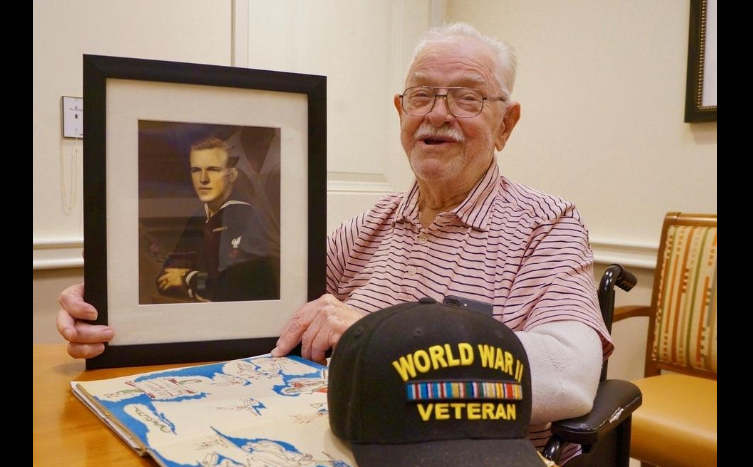U.S. Navy veteran George Bennett, 94, witnessed some of the most historic actions of World War II, including D-Day and the formal Japanese surrender in Tokyo Bay.
As the 75th anniversary of D-Day approached, Bennett, who resides at Belmont Village, a senior living community in Westlake, reflected on the extraordinary events of his life.
In 1943, three weeks after graduating from San Antonio’s Central Catholic high school, he joined the Navy.
“Everyone was going,” he said. “I was 18 years old. It was exciting and scary.”
He took 12 weeks of hospital corps training to learn about wound care and became a pharmacist’s mate 3rd class.
Then, he headed for England where he was later assigned to work on a landing ship transport during the largest seaborne invasion in history on June 6, 1944.
Allied Forces landed more than 160,000 troops at Normandy, of which 73,000 were American.
“My first trip to Normandy was D-Day,′ Bennett said. “We crossed the English channel 21 times, going to five beaches.”
He remembers dodging bombs and bullets to collect the wounded.
“The ramp dropped,” Bennett said. “Then we loaded up 250 wounded. There were two doctors and 20 corpsmen tending to them. We transported American soldiers to hospitals in England.” The ship also carried German prisoners of war to be interned.
“We got down on our knees to attend men on stretchers, taking care of their broken bones and wounds,” Bennett said.
At one point, he aided doctors who had to amputate the gangrenous leg of a German soldier. When asked if he was prepared for the procedure, Bennett replied, “I didn’t have any choice.”
While all of this was happening, he said, “Germans sent planes over us, so we would call the aircraft carriers to intercept their bombardment. We were under attack all the time and constantly moving.”
Miraculously, Bennett was never injured, despite almost three years of service in combat situations in the North Atlantic and Pacific. However, he did suffer significant hearing loss in one ear, which he says was “damaged by the big guns.”
After serving in Europe, he went to Pearl Harbor and joined the destroyer USS Dashiell. He remembers the Dashiell firing torpedoes during intense bombardments from kamikaze flights when 20 planes attacked in Japan.
At the end of the war, the ship returned to Tokyo Bay where the crew witnessed Japanese imperial representatives signing the surrender documents accepted by Gen. Douglas MacArthur on Sept. 2, 1945.
When his tour of duty was over, Bennett went to college at St. Mary’s University in San Antonio, sold cars, owned a plumbing company and later worked for the United Services Automobile Association from which he retired. He married and had seven children. Now he’s widowed with 20 grandchildren and a great-grandchild.
Bennett never returned to Normandy, but his daughter, Diana Preston, said he was grateful to go “with other servicemen on an ‘Honor Flight’ to Washington, D.C. to tour the national memorials.”
“Dad was very touched when he went through the airport,” she said. “People stood and clapped for him and the other men. He was so proud.”
Bennett said he was very fortunate. “It was good service,” he said. “I liked what I did, but it was scary when I did it. I’m most proud that I helped save others and came through good.”
